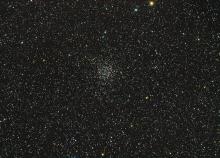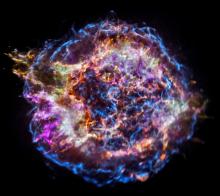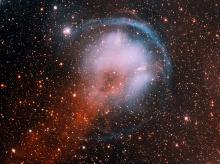Listen to today's episode of StarDate on the web the same day it airs in high-quality streaming audio without any extra ads or announcements. Choose a $8 one-month pass, or listen every day for a year for just $30.
You are here
Owl Cluster
It’s easy to see pictures in the stars. That’s how skywatchers created constellations — they connected the dots of bright stars. But it’s also easy to see pictures on a smaller scale — in star clusters.
One example is NGC 457. Stargazers have given it several names, depending on how they saw it: the Owl, the Dragonfly, and E.T., for the friendly alien in the movie. It’s in the northeast at nightfall, near another star picture: the letter W formed by the stars of Cassiopeia. The nebula’s an easy target for binoculars.
Astronomers have identified several dozen stars in the cluster. But picking out just which stars belong to a cluster takes time. When we look toward a cluster, we see both the cluster and the stars that appear in front of it and behind it. And there’s no way to tell just from looking which star is where.
Astronomers make several measurements to pick out a cluster’s members. First, they measure the motions of the stars — both across the sky and toward or away from Earth. Members of a cluster share a common motion.
But stars that aren’t in the cluster can have similar motions. So astronomers measure the distances to the stars; those in a cluster are at the same distance. The farther the cluster, the trickier that is — it can take years to get it right.
A few other measurements — the ages of the stars, for example — fill in the details — nailing down the list of members of a star cluster.
Script by Damond Benningfield






